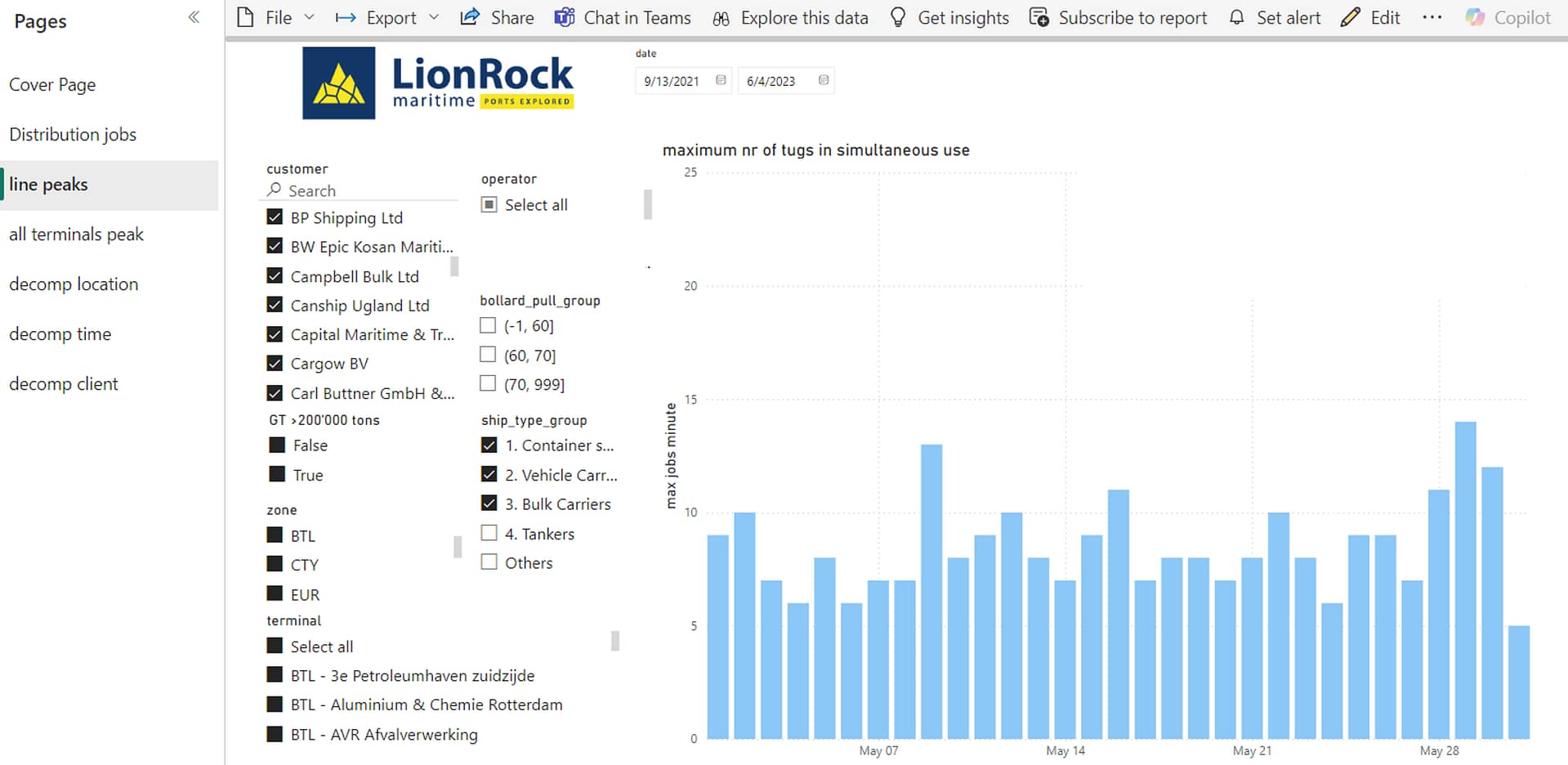Tugboat News | PortExplorer | PortCaptain | Fleet Performance Optimization
Leveraging Market Insights For Tugboat Fleet Expansion | Based on Data
Read Time: 11 mins | Jun 19, 2025 2:00:16 AM | LionRock Maritime

Tugboat Demand Forecast: Leveraging Market Insights For Tugboat Fleet Expansion
Tugboat operators face challenges in fleet expansion, needing to balance fleet size with port demand, regulatory requirements, and customer needs. The Tug Capacity Tool from LionRock Maritime helps optimize fleet management by providing data-driven insights into vessel traffic, peak operating times, and regulatory compliance. By using real-time and historical data, operators can make informed decisions on fleet deployment, ensuring profitable growth and efficient resource utilization, while minimizing the risks of over- or under-deployment.
Introduction – The Necessity Of A Good Tugboat Fleet Management
In today’s competitive maritime industry, tugboat operators are driven by the need to grow their business while optimizing their fleet for maximum efficiency. Tugboat fleet expansion is often the result of strategic market growth, but simply adding more vessels is not enough. Operators must focus on optimizing fleet utilization and resource allocation to ensure operational efficiency and profitability. To achieve this, a data-driven approach is essential. LionRock Maritime’s Tug Capacity Tool offers a solution, providing valuable insights that enable operators to make informed decisions about tugboat fleet management and optimization, aligning fleet size and deployment with real-world market demand. By leveraging these insights, operators can confidently meet customer needs, improve service delivery, and navigate the complexities of fleet expansion with greater precision.
A Peek At Our Tug Capacity Tool
In the picture, the Tug Capacity Tool dashboard reveals peak tugboat demand at various ports, highlighting maximum simultaneous usage across dates. With filters for ship type, tonnage, and terminals, the tool aids maritime companies in identifying high-demand periods and optimizing tug allocation for efficient fleet expansion.

Understanding The Core Challenges Of Tugboat Fleet Expansion
Expanding a tugboat fleet requires more than simply increasing the number of vessels. Operators need to tailor their tugboat fleet expansion to meet the specific needs of ports, customers, and regulatory requirements.
One of the primary challenges is tugboat demand assessment – accurately assessing how many tugs will be required at any given port based on vessel traffic and operational patterns. Failing to assess tugboat demand accurately can lead to severe consequences for tug operators. Under-deployment means operators may lack the capacity to meet peak demand, leading to delays, unsatisfied customers, and strained partnerships with port authorities. On the other hand, over-deployment results in idle tugboats, driving up operational costs with little return on investment. Operators face the difficult balance of maximizing asset use without overburdening resources, and this is where market insights become critical.
To address these challenges, operators need to understand key data points, including:
- Port traffic volume and vessel movements that fluctuate based on port activity.
- Capacity requirements during peak operating times, ensuring enough tugs are available to meet demand.
- Individual customer needs, including shipping lines and terminal operations, which vary by location and partnership.
- Port/pilot regulations and requirements, which often dictate how many and what types of tugs are needed to assist vessels at specific terminals.
Port and pilot regulations are an especially crucial factor that operators must adhere to when planning tugboat fleet expansion. Each port authority has its own set of guidelines that specify how many tugs are required to assist different types of vessels at specific terminals, and the kind of tugboats necessary for these operations. These regulations ensure both safety and operational efficiency in increasingly busy ports. For example, larger vessels may require multiple high bollard pull tugs simultaneously, and regulations might even define how tugs should be positioned or deployed.
By incorporating these factors, operators can make more accurate decisions about their tugboat fleet management, ensuring that fleet expansion is aligned with both current and future demand.
The Tug Capacity Tool: A Game-Changer For Informed Decision-Making
To help operators address the complexities of tugboat fleet expansion, LionRock Maritime developed the Tug Capacity Tool. This tool provides operators with valuable market insights that enable them to make data-driven decisions regarding tugboat demand forecasting and fleet deployment.
The Tug Capacity Tool analyzes a range of factors, such as daily vessel traffic, peak operating times, and customer profiles, to help tug operators calculate the exact number of tugs needed. By capturing real-time data and breaking down tugboat demand by the day, hour, and even minute, the tool provides a detailed analysis of port activity. It also factors in regulatory compliance, ensuring operators meet local port guidelines on tugboat deployment.
One of the tool’s standout features is its customizable input function. Operators can adjust various parameters, such as customer type (shipping lines, terminals) and different terminal scenarios. This enables them to simulate different operations and determine the optimal fleet size for each situation, making the tool indispensable for both tugboat fleet management and expansion planning.
Additionally, the tool allows operators to integrate historical data with real-time analytics. This means that past trends in port traffic, peak seasons, and customer preferences are combined with current activity to provide a comprehensive picture. For operators targeting in or cross-port expansion, this historical insight offers significant strategic advantages, allowing them to assess how many tugs will be required from the outset and what kind of fleet adjustments may be needed as operations grow. This enhances decision-making accuracy, further reducing risks associated with fleet over-expansion or under-deployment.
Leveraging Market Insights For Profitable Fleet Expansion
The strategic use of market data is crucial to ensuring that tugboat fleet expansion is both profitable and efficient. Tugboat demand forecasting helps operators expand their fleets in line with real-world demand, minimizing costly miscalculations and optimizing resource allocation.
By analyzing shipping traffic trends, operators can better anticipate port activity fluctuations. This allows them to adapt their fleets to seasonal demands and avoid idle vessels during off-peak times. Furthermore, the Tug Capacity Tool enables operators to make confident decisions when entering new ports or expanding their services in existing ones.
Effective tugboat fleet management also ensures operational agility, allowing operators to dynamically adjust fleet sizes as demand changes. Real-time data analysis provides continuous feedback, helping operators monitor performance and refine their strategies to meet customer needs. By tailoring their fleet to high-priority customers or specific vessel types, operators can enhance customer satisfaction and increase retention rates.
With the Tug Capacity Tool, tugboat operators can make informed decisions that lead to profitable growth, balancing fleet expansion with operational efficiency. This data-driven approach optimizes fleet utilization and ensures compliance with port regulations, making it a valuable asset for sustainable fleet management.
Conclusion – Optimal Tugboat Fleet Expansion
In the competitive world of maritime operations, leveraging market insights is key to effective tugboat fleet expansion. By using tools like the Tug Capacity Tool, operators can make data-driven decisions that align fleet size with real-world demand, customer expectations, and regulatory requirements. This approach ensures that tugboat fleet management is both profitable and sustainable, helping operators navigate the complexities of fleet expansion while optimizing resource allocation and improving customer satisfaction. As the industry continues to evolve, the strategic use of market data will remain essential for achieving long-term growth and success.
Optimize Your Fleet With Data-Driven Precision
Ready to take your fleet optimization to the next level? LionRock Maritime’s industry expertise and Tug Capacity Tool can help you stay ahead of market trends, making informed decisions that align with real demand. Harness data to guide your next move and ensure efficient, profitable growth for your operations.
Frequently Asked Questions
FAQ: Data-Driven Tugboat Fleet Expansion
Why Is A Data-Driven Approach Crucial For Tugboat Fleet Expansion?
A data-driven approach is essential because tugboat fleet expansion isn’t just about adding more vessels; it’s about aligning fleet size with real-world demand to avoid underutilization or over-commitment. The Tug Capacity Tool help operators analyze key data points such as port traffic, peak demand times, and customer requirements. By using accurate tugboat demand assessment, operators can make informed decisions that ensure their fleet is the right size and efficiently deployed, resulting in profitable growth and streamlined operations.
How Does The Tug Capacity Tool Help With Tugboat Demand Forecasting?
The Tug Capacity Tool assists operators in accurately assessing how many tugs are needed at any given port. It analyzes real-time data like vessel traffic and customer activity, while also considering historical trends. This allows operators to generate precise tugboat demand assessments by the day, hour, and even minute, helping them avoid over-deployment and under-deployment scenarios. Ultimately, the tool ensures that operators are always equipped with the right number of tugs to meet both peak and off-peak demand.
What Are The Key Challenges Tugboat Operators Face When Managing Tugboat Fleet Expansion?
One of the main challenges in tugboat fleet expansion is finding the balance between adding vessels and ensuring they are effectively utilized. Operators need to assess not only current demand but also future growth while complying with port and pilot regulations. Miscalculating fleet size can lead to inefficiencies like idle tugs or, conversely, delays due to insufficient capacity. Utilizing market data and tools like the Tug Capacity Tool helps operators address these challenges by optimizing fleet size and deployment based on comprehensive insights.
How Can Leveraging Market Insights Improve Tugboat Fleet Management?
Leveraging market insights allows for better tugboat fleet management by providing operators with a clear understanding of vessel traffic patterns, customer needs, and port-specific regulations. This helps operators dynamically adjust their fleet to meet evolving demand and customer expectations, reducing downtime and improving profitability. By using real-time data, operators can fine-tune their strategies to increase operational efficiency, maintain high service levels, and achieve sustainable growth.
Get Started Today
Improve your maritime towage operations today.
Schedule a demo to see how our tugboat analytics can help you grow your business ahead of competition and save operational costs.